

| Stateflow |   |
Example: Event Broadcast State Action
This example shows the semantics of event broadcast state actions.
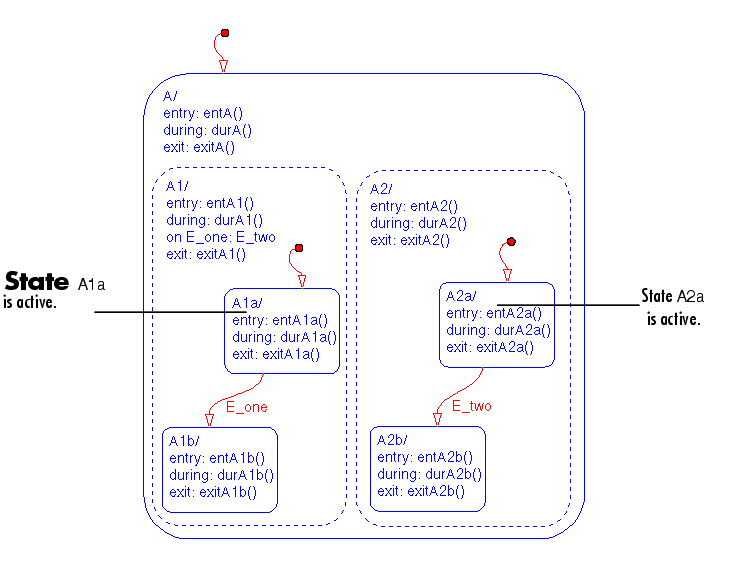
Initially the Stateflow diagram is asleep. Parallel substates A.A1.A1a and A.A2.A2a are active. Event E_one occurs and awakens the Stateflow diagram. Event E_one is processed from the root of the Stateflow diagram down through the hierarchy of the Stateflow diagram:
E_one. There is no valid transition.
A executes and completes during actions (durA()).
A.A1 is evaluated first. State A.A1 executes and completes during actions (durA1()). State A.A1 executes and completes the on E_one action and broadcasts event E_two. during and on event_name actions are processed based on their order of appearance in the state label.
E_two awakens the Stateflow diagram a second
time. The Stateflow diagram root checks to see if there is a valid
transition as a result of E_two. There is no valid transition.
during actions (durA()).
A.A1. State A.A1
executes and completes during actions (durA1()). State A.A1 is evaluated
for valid transitions. There are no valid transitions as a result of E_two
within state A1.
A.A2 is evaluated. State A.A2 executes and completes during actions
(durA2()). State A.A2 checks for valid transitions. State A.A2 has a valid
transition as a result of E_two from state A.A2.A2a to state A.A2.A2b.
A.A2.A2a exit actions execute and complete (exitA2a()).
A.A2.A2a is marked inactive.
A.A2.A2b is marked active.
A.A2.A2b entry actions execute and complete (entA2b()). The
Stateflow diagram activity now looks like this
A.A1.A1a executes and completes exit actions (exitA1a).
E_one continues once the on event broadcast of E_two has been processed. State A.A1 checks for any valid transitions as a result of event E_one. There is a valid transition from state A.A1.A1a to state A.A1.A1b.
A.A1.A1a is marked inactive.
A.A1.A1b executes and completes entry actions (entA1b()).
A.A1.A1b is marked active.
A.A2 is evaluated next. State A.A2 during actions execute and complete (durA2()). There are no valid transitions as a result of E_one.
A.A2.A2b, now active as a result of the processing of the on event broadcast of E_two, executes and completes during actions (durA2b()).
This sequence completes the execution of this Stateflow diagram associated with event E_one and the on event broadcast to a parallel state of event E_two. The final Stateflow diagram activity looks like this.
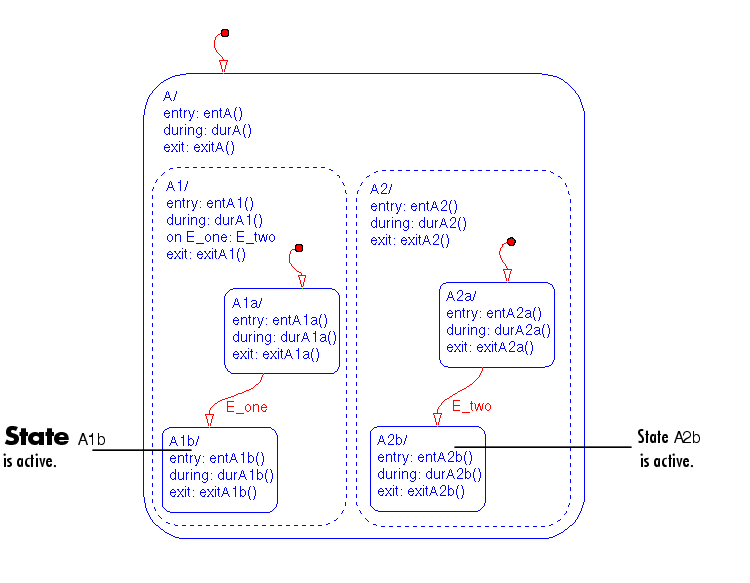
Example: Event Broadcast Transition Action (Nested Event Broadcast)
This example shows the semantics of an event broadcast transition action that includes nested event broadcasts.
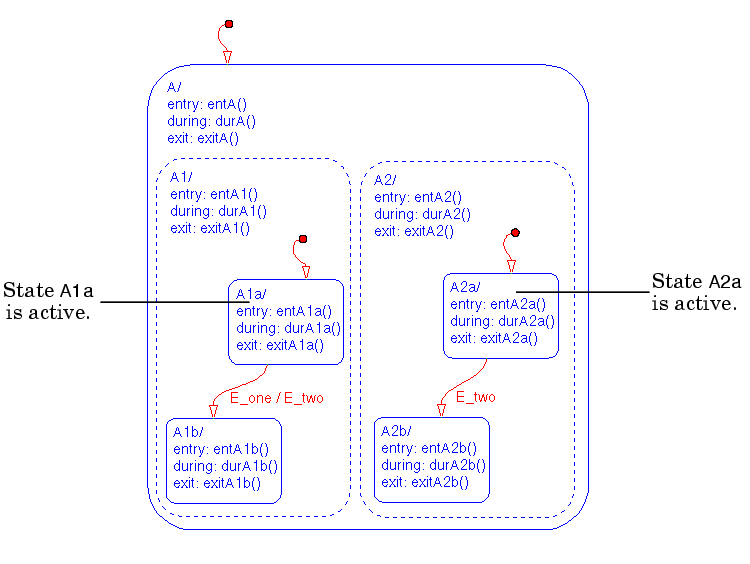
Start of event E_one Processing
Initially the Stateflow diagram is asleep. Parallel substates A.A1.A1a and A.A2.A2a are active. Event E_one occurs and awakens the Stateflow diagram. Event E_one is processed from the root of the Stateflow diagram down through the hierarchy of the Stateflow diagram:
E_one. There is no valid transition.
A executes and completes during actions (durA()).
A.A1 is evaluated first. State A.A1 executes and completes during actions (durA1()).
A.A1 checks for any valid transitions as a result of event E_one. There is a valid transition from state A.A1.A1a to state A.A1.A1b.
A.A1.A1a executes and completes exit actions (exitA1a).
A.A1.A1a is marked inactive.
Event E_two Preempts E_one
E_two is executed and completed.
A1a to state A1b (as a result of event E_one) is
now preempted by the broadcast of event E_two.
E_two awakens the Stateflow diagram a second
time. The Stateflow diagram root checks to see if there is a valid
transition as a result of E_two. There is no valid transition.
during actions (durA()).
A.A1. State A.A1
executes and completes during actions (durA1()). State A.A1 is evaluated
for valid transitions. There are no valid transitions as a result of E_two
within state A1.
A.A2 is evaluated. State A.A2 executes and completes during actions
(durA2()). State A.A2 checks for valid transitions. State A.A2 has a valid
transition as a result of E_two from state A.A2.A2a to state A.A2.A2b.
A.A2.A2a exit actions execute and complete (exitA2a()).
A.A2.A2a is marked inactive.
A.A2.A2b is marked active.
A.A2.A2b entry actions execute and complete (entA2b()).
Event E_two Processing Ends
The Stateflow diagram activity now looks like this.
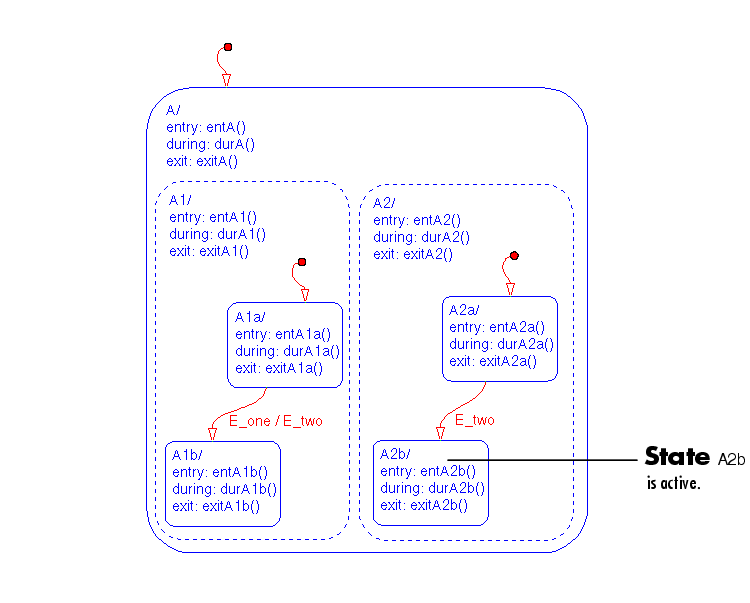
A.A1.A1b is marked active.
Event E_one Processing Resumes
A.A1.A1b executes and completes entry actions (entA1b()).
A.A2 is evaluated next. State A.A2 during actions execute and complete (durA2()). There are no valid transitions as a result of E_one.
A.A2.A2b, now active as a result of the processing of the transition action event broadcast of E_two, executes and completes during actions (durA2b()).
This sequence completes the execution of this Stateflow diagram associated with event E_one and the transition action event broadcast to a parallel state of event E_two. The final Stateflow diagram activity now looks like this.
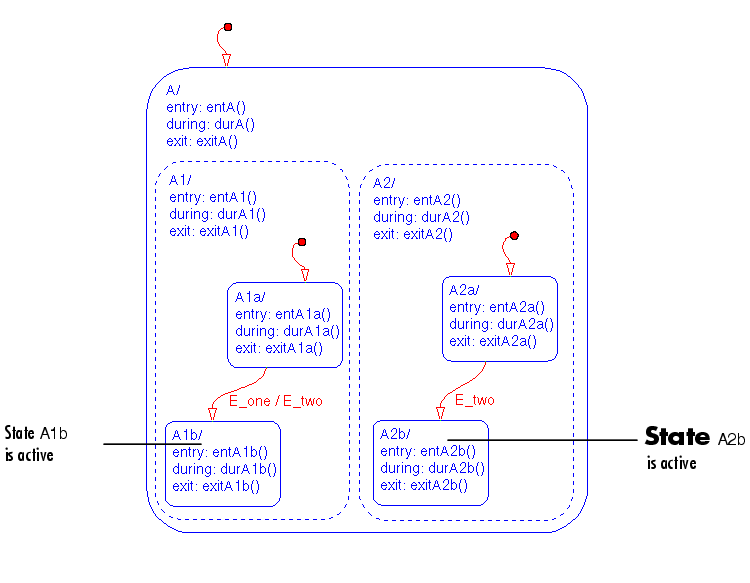
Example: Event Broadcast Condition Action
This example shows the semantics of condition action event broadcast in parallel (AND) states.
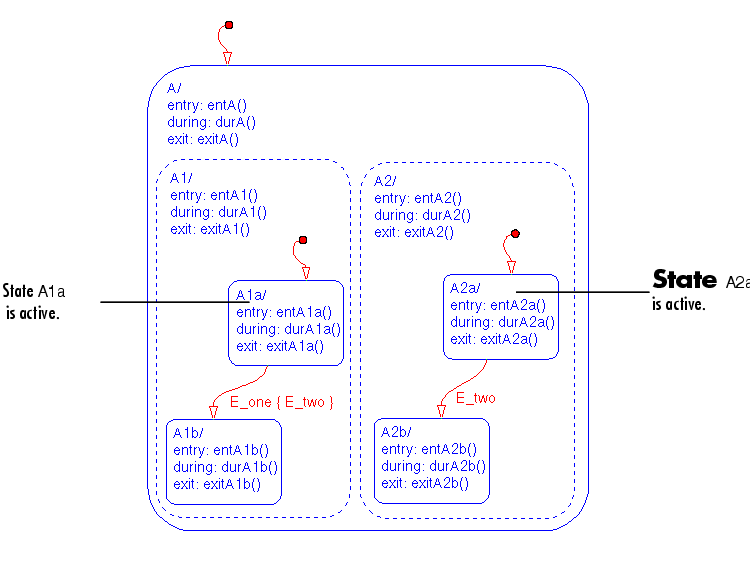
Initially the Stateflow diagram is asleep. Parallel substates A.A1.A1a and A.A2.A2a are active. Event E_one occurs and awakens the Stateflow diagram. Event E_one is processed from the root of the Stateflow diagram down through the hierarchy of the Stateflow diagram:
E_one. There is no valid transition.
A executes and completes during actions (durA()).
A.A1 is evaluated first. State A.A1 executes and completes during actions (durA1()).
A.A1 checks for any valid transitions as a result of event E_one. There is a valid transition from state A.A1.A1a to state A.A1.A1b. There is also a valid condition action. The condition action event broadcast of E_two is executed and completed. State A.A1.A1a is still active.
E_two awakens the Stateflow diagram a second
time. The Stateflow diagram root checks to see if there is a valid
transition as a result of E_two. There is no valid transition.
during actions (durA()).
A.A1. State A.A1
executes and completes during actions (durA1()). State A.A1 is evaluated
for valid transitions. There are no valid transitions as a result of E_two
within state A1.
A.A2 is evaluated. State A.A2 executes and completes during actions
(durA2()). State A.A2 checks for valid transitions. State A.A2 has a valid
transition as a result of E_two from state A.A2.A2a to state A.A2.A2b.
A.A2.A2a exit actions execute and complete (exitA2a()).
A.A2.A2a is marked inactive.
A.A2.A2b is marked active.
A.A2.A2b entry actions execute and complete (entA2b()).
The Stateflow diagram activity now looks like this.
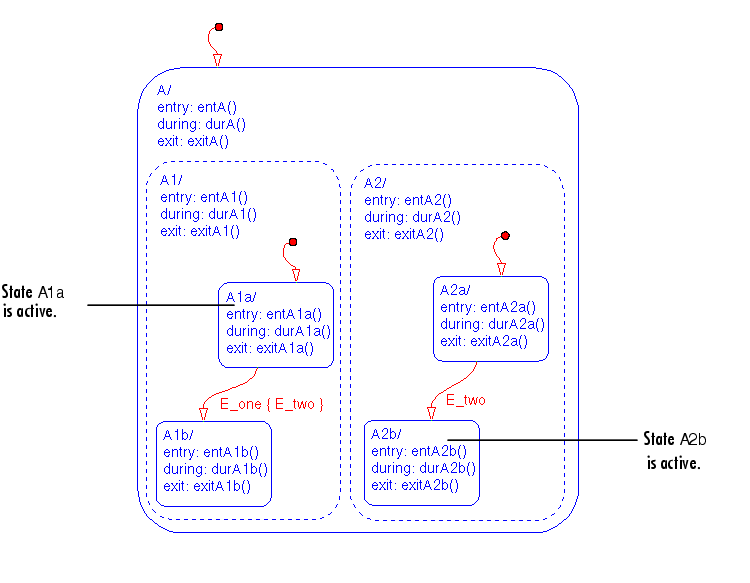
A.A1.A1a executes and completes exit actions (exitA1a).
A.A1.A1a is marked inactive.
A.A1.A1b executes and completes entry actions (entA1b()).
A.A1.A1b is marked active.
A.A2 is evaluated next. State A.A2 during actions execute and complete (durA2()). There are no valid transitions as a result of E_one.
A.A2.A2b, now active as a result of the processing of the condition action event broadcast of E_two, executes and completes during actions (durA2b()).
This sequence completes the execution of this Stateflow diagram associated with event E_one and the condition action event broadcast to a parallel state of event E_two. The final Stateflow diagram activity now looks like this.
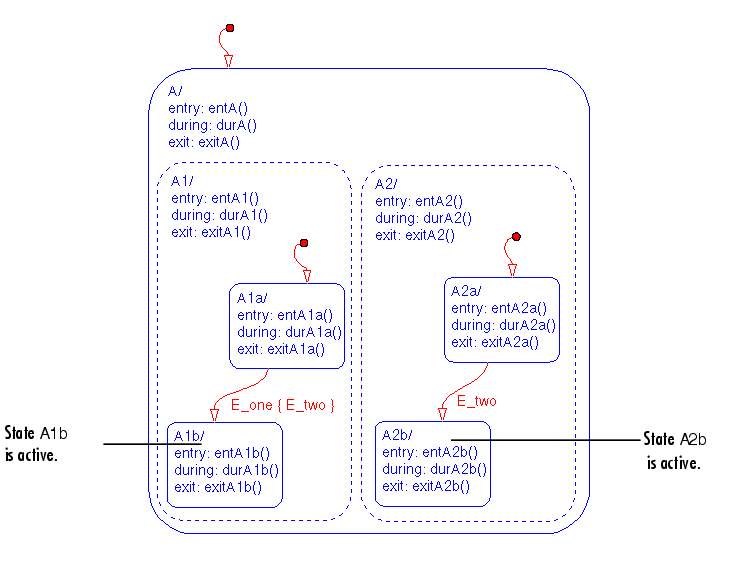
 | Event Actions | Directed Event Broadcasting |  |